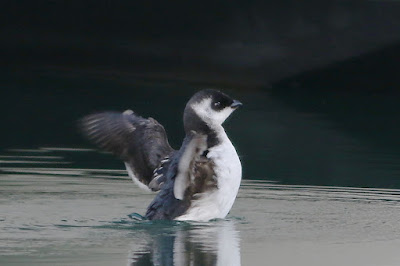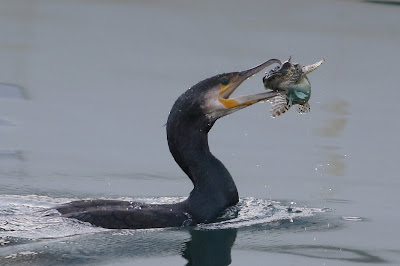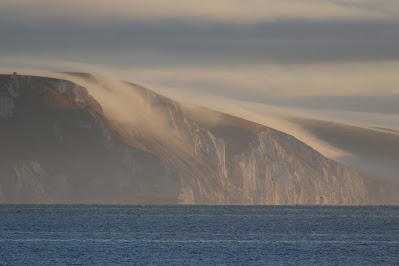By Christmas Day I had seemingly exhausted all the possibilities which Dorset offered to add to the non-motorised year list. At this late stage of the year, it would have been tempting to hang up my bicycle clips and settle for the grand total of 221 species which had been amassed thus far. But while the Dorset possibilities may have been exhausted, there was always Hampshire...
Following reports of a Great Grey Shrike in the New Forest earlier in the winter I had been contemplating a big day in the area. Unfortunately the Shrike had gone off the radar several weeks ago, but potentially three December 'ticks' were still available if I was willing to make the effort.
 |
| Female Red-crested Pochard, Ibsley North |
A good plan, some luck and preferably decent weather would likely be needed to see all three, and the last of these wasn't really an option as every day between Christmas Day and New Year looked wet and windy to varying degrees. Tuesday 28th looked like the least worst, with a strong westerly wind to hasten my passage over the county border. This wouldn't be much help on the way home but it was due to ease off and I figured I could cross that bridge when I came to it.
 |
| The cunning plan |
A plan was therefore hatched on a scrap of paper the night before (see pic above) - all I had to do now was execute it. The first step - get on the road by 0830 - was straightforward enough. Packing the bike these days with enough clothes, food and fluids for a full day in the field without even needing to stop at a shop is quite a challenge, but I got it organised the night before and was out of the door a few minutes early.
 |
| Red-crested Pochard (female), Ibsley North |
First stop was Upton, just 7 miles from home, for another look at the Bean Geese which were looking good as the sun rose. John Wall arrived to pap them with his big lens, making my lame efforts at photography feel a bit redundant. And besides, there was no time to waste if I was to get to my next target - a Red-crested Pochard at Ibsley North lake, a further 17 miles to the east - by the allotted time of 1100.
East Dorset birder Olly Frampton had been keeping tabs on the Red-crested Pochard, a female, which had been present a few weeks, and he very kindly confirmed its continued presence early morning, giving me the incentive to press on despite the deteriorating weather at my back. Google maps for cycling is pretty good, but on this occasion, having taking me over the Canford bridge - a narrow 3 plank job with gaps between the planks big enough for my wheels to slip through - it then directed me along the muddy bank of the River Stour to a double stile, requiring heavy panniers to be removed before the bike could be lifted over. Unhelpfully, the weather chose this moment to do its worst, and by the time everything was reassembled I was seriously wet and doubting the wisdom of the exercise.
 |
| Essence of Fudge Duck (!), Kingfisher Lake |
But since when did wisdom have anything to do with the non-motorised year list! I pressed on and found Ibsley North lake without too much trouble thanks to Olly's excellent directions. A couple of Portsmouth birders had just arrived and one of them located the RCP within minutes. I had lost a bit of time against schedule on the way over, but this quick result more than clawed it back. While a satisfying addition to the year list, this was not really a bird to quicken the pulse so after some manual focus record shots through the trees, I resolved to quickly move on to my next target a couple of miles back down the A338: the Ferruginous Duck at Kingfisher Lake.
This returning bird has some notoriety as Kingfisher Lake is surrounded by a 6 foot fence, clad with a solid canvas matting to protect the bashful fishermen inside from view. Famously, therefore, visiting birders wishing to see the Fudge Duck are advised to bring a stepladder! Such a thing would not fit in my panniers, but the Portsmouth lads had brought one so I arranged to meet them there in case it came in handy. It turned out that standing on the bike pedals gave me just enough height to see over the fence, but we scoured the fence line looking for a clear view in vain.
 |
| Ferruginous Duck (left) with Wigeon |
I found a candidate bird through a hole in the fence but it materialised into a female Tufted Duck. We eventually found a reasonable view point which revealed a flock of Goosander and other mixed duck in the centre of the lake. Picking through them whilst perched on the pedals, right at the back a dark bird with a white bum and peaked crown caught my eye. Views through the scope balanced on barbed wire, and a few record shots confirmed it was the Fudge Duck. The Pompey lads were delighted and I was pleased to have repaid my debt to them for finding the RCP.
With two year-ticks in the bag, lunch - the inevitable leftover turkey sandwich - was taken sheltering from the rain and wind under a bush. The sensible thing to do at this point would have been to give up on the third target for the day - a New Forest Hawfinch - head home and be satisfied with the day's haul. But since when did sensible have anything to do with the non-motorised year list! The plan dictated that I would need to be at Blackwater Arboretum - a well known pre-roost site for Hawfinch - another dozen or so miles to the east - by mid-afternoon.
 |
| Ferruginous Duck showing sharply demarcated white belly |
From Kingfisher Lake there were two options to head into the New Forest: east along Ivy Lane and across Broomy Plain before cutting under the A31 to Bolderwood and on to Blackwater; or south to Ringwood before heading east via Burley. Olly had advised that Hawfinches might be seen at Bolderwood so it made sense to try there first and, with luck, I could be on the way home well before dark. The ride through the New Forest was glorious, the sun came out for the first time all day, and I clocked an impressive 34.5mph as I coasted down through Slufters Inclosure to the A31.
As it turned out, I couldn't locate the target species at Bolderwood, so to Blackwater it was, with precise directions provided by Phil Saunders who had seen Hawfinch there within the last couple of weeks. As I rolled into the Arboretum, it was a nice surprise to see Garry Hayman, who has been present at the end of several of my long distance bike twitches this year, and his wife, obviously also hoping for a Hawfinch.
 |
| The wheels at Bolderwood |
The less good news was that they had been there since 1300 and not seen a thing! Still, I had come all this way - clocking up 40 miles by this point - so there was nothing for it but to set up scope and hope for the best. At 1545, scanning with bins in rapidly fading light, I noticed a previously unseen lump in the top of a distant pine and a quick check through the scope confirmed my suspicions: Hawfinch! I got Garry onto it and after a few quick record shots it was time to pack up and begin the long journey home.
I took the Burley route back to Ringwood, crossed the Dorset border and followed the excellent Castleman Trailway as far as Ferndown before heading for the comfort of tarmac for the final 15 miles. At 1930 I completed the 73.5 mile epic - my second longest journey this year after Lyme Regis in June - and could safely chalk up three more additions to the year list. Barring something extraordinary happening on New Years Eve, that really does look like it for the year - a grand total of 224 species seen travelling under my own steam, all but 4 of these in Dorset.
 |
| Hawfinch, Blackwater Arboretum, 28th December |



















































